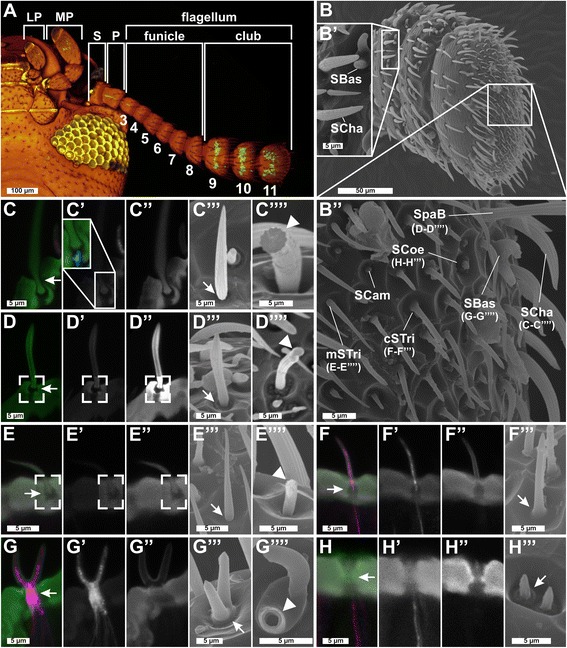Fig. 1.

Sensilla types and distribution on Tribolium castaneum antennae I. a Chemosensory sensilla are restricted to the distal three segments (9–11) of the T. castaneum antenna, which is composed of scape (S), pedicel (P), and flagellum, and the last labial palp (LP) and maxillary palp (MP) segment. CLSM-stack voltex projection of a transgenic beetle head (ventral view, green: partial Orco-Gal4/UAS-tGFP; yellowish eye, brownish cuticle: autofluorescence). b–b'' SEM images of the club segments with close-up of segments 9 (b') and 11 (b''). Single sensilla: CLSM maximum intensity projection overlays (c–h) of antibody-enhanced EF1-B-DsRed reporter signal (magenta, c'–h') and cuticle autofluorescence (green, c''–h''). c'''–h''' SEM analysis. Mechanoreceptive sensilla: SCam are small, smooth, and dome-shaped sensilla restricted to segment 11 (Additional file 3: Figure S3a); SCha – previously described as spines [90] – are longitudinally corrugated, connected to a neuron at the socket (c'; blue), jointed (c'''; arrow), and solid (c''''; arrowhead). d–d'''' SpaB – in T. brevicornis called sensilla squamiformium [95] – resemble modified (slightly thicker tip) SCha [96] restricted to segment 11 (Additional file 3: Figure S3b). e–e'''' mSTri (structurally similar to SCha but smaller more hair-like appearance) have previously been described in other species [24, 244]. CLSM analysis showed joint-like structures at the base (c–e, c''–e'', open squares) of the mechanoreceptive sensilla and SEM revealed a small gap at their base (c'''–e''', arrow). Chemoreceptive sensilla: f–f''' cSTri are hair-like structures restricted to segment 11 (Additional file 3: Figure S3d) with a rounded tip and a smooth transition of the base; g–g'''' SBas are smooth-surfaced pegs with rounded tips and smooth transitions at the base (g'''; arrow). h–h''' SCoe are short and corrugated, and their transition into the antennal cuticle shows a typical elevation (b'', h'''). All chemoreceptive sensilla (f, g, f'–h') house dendritic branches of CSNs labeled by DsRed. The close-up in c' shows a non-CSN fiber entering only the base of a SCha labeled with phalloidin (blue). Chemoreceptive sensilla show a smooth transition into the antennal cuticle (f'''–h''', arrow). Whereas all mechanoreceptive sensilla are solid cuticular structures (fractured in c''''–e''''), chemoreceptive SBas appear hollow (fractured in g''''). CLSM confocal laser-scanning microscopy, CSN chemosensory neuron, cSTri chemosensilla trichoidea, LP labial palp, MP maxillary palp, mSTri mechanosensilla trichoidea, P pedicel, S scape, SBas sensilla basiconica, SCam sensilla campaniformes, SCha sensilla chaetica, SCoe sensilla coeloconica, SEM scanning electron microscopy, SpaB spaculate bristle
